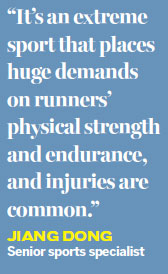Why marathons can be deadly in the long run
Anyone contemplating running a marathon would be well advised to consider Pheidippides, the messenger in ancient Greece whose long-distance running feat gave us the word marathon and the race that goes with it. Within minutes of arriving in Athens and delivering a message of victory in battle, the exhausted Pheidippides died.
In the 120 years since the first marathon was run at the founding of the modern Olympic Games, many have worn the laurels of victory after the race, or simply savored the satisfaction of being able to finish it but, as with Pheidippides, the extreme physical stress has cost a few their lives, too. While such deaths are not that common, they are likely to rise as the number of marathon events increases.
The risk of injury is integral to marathon running and medical experts warn that anyone taking part should do so only after sufficient preparation, which usually takes many months.
"It's an extreme sport that places huge demands on runners' physical strength and endurance, and injuries are common," says Jiang Dong, a senior specialist with the Institute of Sports Medicine of Peking University Third Hospital.
The lower limbs are especially susceptible to injury, he says, citing synovitis and cartilage injuries to the hips, knees, ankles, tendons and ligaments, as well as muscle strain.
It is essential that prospective marathoners do regular, step-by-step training over an extended period to increase muscle strength, he says.

With weak muscles, the muscle around joints fatigues easily and cannot provide support to stabilize joints. That is why many marathon runners often feel sore and have pains in their joints and feel weak when they climb stairs.
Those running in a marathon need to be in the very best physical shape, Jiang says.
Runners particularly susceptible to injury are those who have failed to warm up properly before the big race or who have slept poorly beforehand or are tired for other reasons.
Also, given that running marathons demands full-body movement, correct posture is critical. Anyone leaning forward or backward while they run risks cervical and lumbar spine injuries, he says, and pounding the ground too hard runs the risk of foot, knee and other injuries to the lower limbs.
Running a marathon requires energy, and provision of energy in the form of sport drinks, fruit and energy mixes before and during running prevents problems like dehydration. A lack of nutrition can also cause fatigue and cramps, and reduce concentration and physical coordination, thus increasing the chance of sprains.
Zhao Wei, a senior heart disease specialist with the hospital, also warns of athletic sudden death. This refers to non-traumatic sudden death during or within 24 hours of taking part in sports, sudden cardiac death being the most common.
Most sudden cardiac death is caused by heart disease. Among those under 35, heart disease is often related to hereditary or congenital heart deformities, such as coronary malformations and hypertrophic cardiomyopathy or thickening of the heart muscle, she says.
Among those above 35, athletic sudden death is most often caused by coronary heart disease.
No matter what a person's cardiac condition is, sudden and excessive exercise is often a risk factor for sudden death, she says.
Anyone who seldom exercises and then suddenly runs a great distance risks suffering acute ischemia leading to ventricular fibrillation or other forms of arrhythmia, a condition in which the heartbeat is abnormal and which can be fatal.
Zhao suggests anyone considering long-distance running or any other extremely demanding physical activity have a thorough medical examination first.
Anyone running or performing other physical activities who has chest pain, shortness of breath, dizziness or abnormal fatigue would be wise to stop running or exercising immediately, Zhao says.
Cardiopulmonary resuscitation can save lives, and it is advisable for everyone taking part in long-distance to learn it, she says.
(China Daily European Weekly 03/03/2017 page16)


















